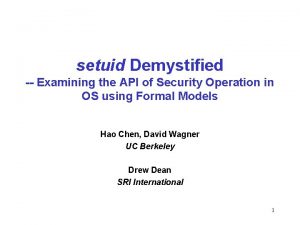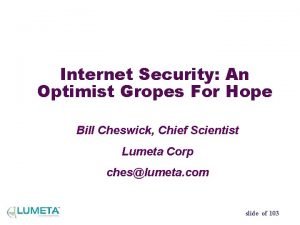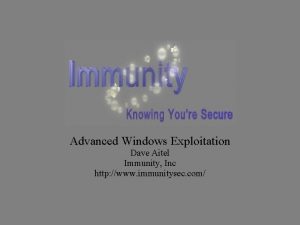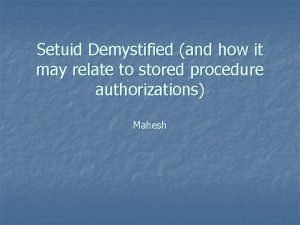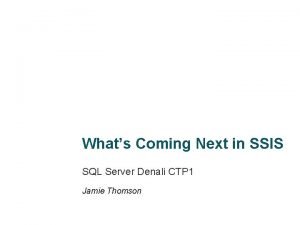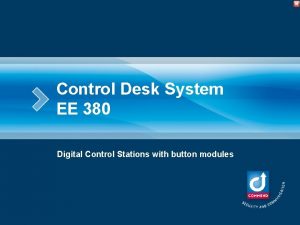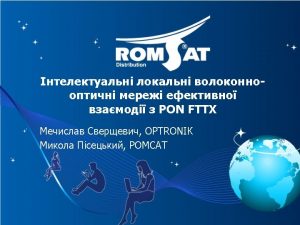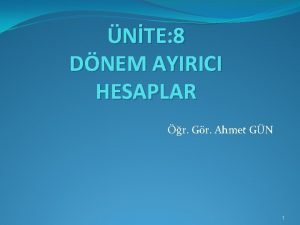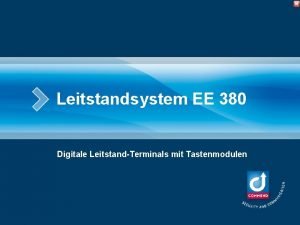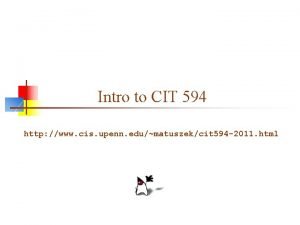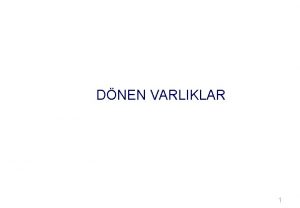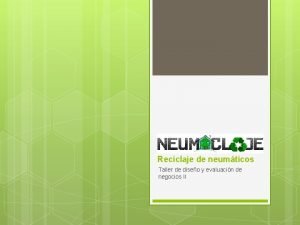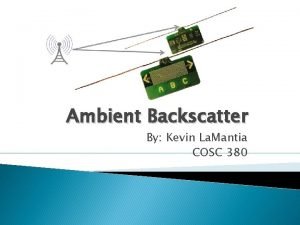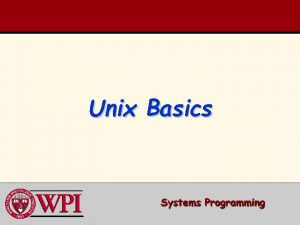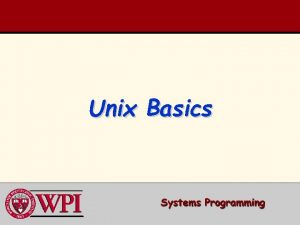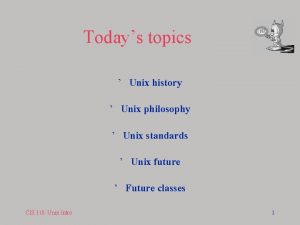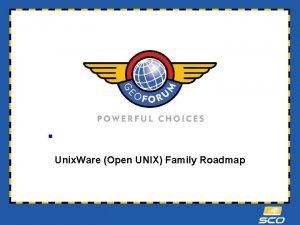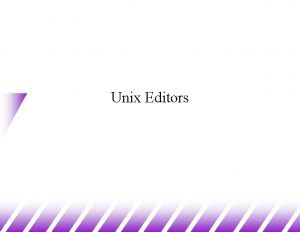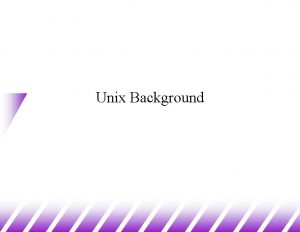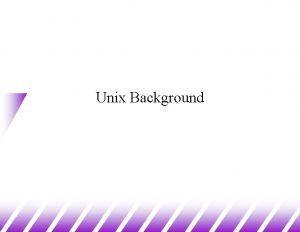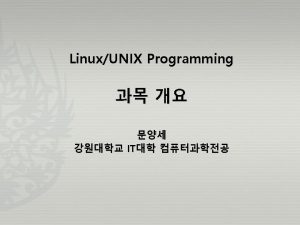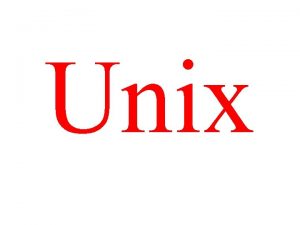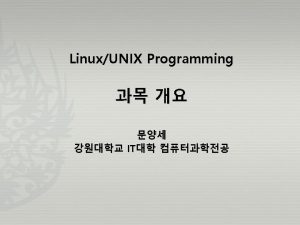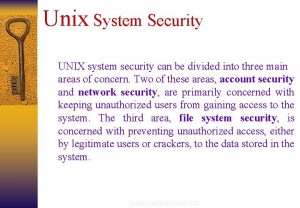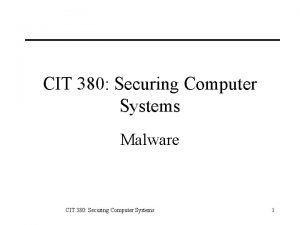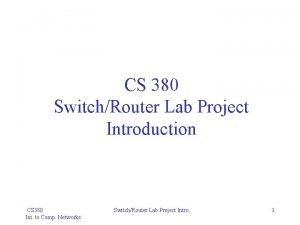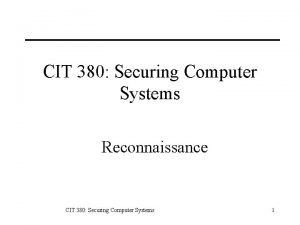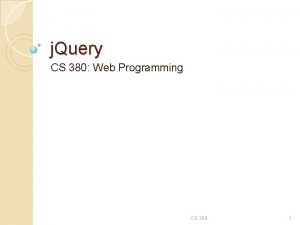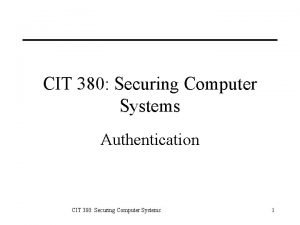CS 380 S UNIX Security setuid and chroot
















![WU-FTPD Attack [Chen et al. “Non-Control-Data Attacks”] This attack involves no illegitimate control transfers! WU-FTPD Attack [Chen et al. “Non-Control-Data Attacks”] This attack involves no illegitimate control transfers!](https://slidetodoc.com/presentation_image_h/c43cb3ca59301456c2ca9c009ce2c03f/image-17.jpg)













![MOPS Results [Chen et al. ] u. Experiment: analyze an entire Linux distribution • MOPS Results [Chen et al. ] u. Experiment: analyze an entire Linux distribution •](https://slidetodoc.com/presentation_image_h/c43cb3ca59301456c2ca9c009ce2c03f/image-31.jpg)
- Slides: 31

CS 380 S UNIX Security: setuid and chroot Static Security Analysis with MOPS Vitaly Shmatikov slide 1

Reading Assignment u. Chen, Wagner and Dean: “Setuid Demystified” (USENIX Security 2002) and “Model Checking One Million Lines of C Code” (NDSS 2004). slide 2

Users and Superusers in UNIX u. A user has username, group name, password shmat, UID 13630 prof, GID 30 “Wouldntcha. Like. To. Know” u. Root is an administrator / superuser (UID 0) • Can read and write any file or system resource (network, etc. ) • Can modify the operating system • Can become any other user – Execute commands under any other user’s ID • Can the superuser read passwords? slide 3

Access Control in UNIX u. Everything is a file • Files are laid out in a tree • Each file with associated with an inode data structure uinode records OS management information about the file • UID and GID of the file owner • Type, size, location on disk • Time of last access (atime), last inode modification (ctime), last file contents modification (mtime) • Permission bits slide 4

UNIX Permission Bits -rw-r--r-- 1 shmat prof 116 Sep 5 11: 05 midterm. tex Access rights of file owner File type Access rights of everybody else - regular file Access rights of group members d directory b block file Permission bits c character file r read l symbolic link w write p pipe x execute (if directory, traverse it) s socket s setuid, setgid (if directory, files have gid of dir owner) t sticky bit (if directory, append-only) slide 5

Basic UNIX Security Mechanisms usetuid() allows a system process to run with higher privileges than those of the user who invoked it • Enables controlled access to system resources such as email, printers, etc. • 99% of local vulnerabilities in UNIX systems exploit setuid-root programs to obtain root privileges – The other 1% target the OS itself uchroot() confines a user process to a portion of the file system slide 6

chroot() Jail u. In Unix, chroot() changes root directory • Originally used to test system code “safely” • Confines code to limited portion of file system • Sample use: chdir /tmp/ghostview chroot /tmp/ghostview su tmpuser (or su nobody) u. Potential problems • chroot changes root directory, but not current dir – If forget chdir, program can escape from changed root • If you forget to change UID, process could escape slide 7

Only Root Should Execute chroot() u. Otherwise, jailed program can escape mkdir(/temp) /* create temp directory */ chroot(/temp) /* now current dir is outside jail */ chdir(“. . /. ”) /* move current dir to true root dir */ OS prevents traversal only if current root is on the path… is it? chroot(“. ”) /* out of jail */ u. Otherwise, anyone can become root • Create fake password file /tmp/etc/passwd • Do chroot(“/tmp”) • Run login or su (if available in chroot jail) – Instead of seeing real /etc/passwd, it will see the forgery slide 8

jail() u. First appeared in Free. BSD u. Stronger than chroot() • Each jail is bound to a single IP address – Processes within the jail cannot use other IP addresses for sending or receiving network communications • Only interact with other processes in the same jail u. Still too coarse • Directory to which program is confined may not contain all utilities the program needs to call • If copy utilities over, may provide dangerous weapons • No control over network communications slide 9

Extra Programs Needed in Jail u. Files needed for /bin/sh • • • /usr/ld. so. 1 /dev/zero /usr/libc. so. 1 /usr/libdl. so. 1 /usr/libw. so. 1 /usr/libintl. so. 1 shared object libraries clear memory used by shared objs general C library dynamic linking access library Internationalization library u. Files needed for perl • 2610 files and 192 directories slide 10

Process IDs in UNIX u. Each process has a real UID (ruid), effective UID (euid), saved UID (suid); similar for GIDs • Real: ID of the user who started the process • Effective: ID that determines effective access rights of the process • Saved: used to swap IDs, gaining or losing privileges u. If an executable’s setuid bit is set, it will run with effective privileges of its owner, not the user who started it • E. g. , when I run lpr, real UID is shmat (13630), effective UID is root (0), saved UID is shmat (13630) slide 11

Dropping and Acquiring Privilege u. To acquire privilege, assign privileged UID to effective ID u. To drop privilege temporarily, remove privileged UID from effective ID and store it in saved ID • Can restore it later from saved ID u. To drop privilege permanently, remove privileged UID from both effective and saved ID slide 12

Setting UIDs Inside Processes usetuid(newuid) • If process has “appropriate privileges”, set effective, real, and saved ids to newuid • Otherwise, if newuid is the same as real or saved id, set effective id to newuid (Solaris and Linux) or set effective, real, and saved ids to newuid (BSD) u. What does “appropriate privileges” mean? • Solaris: euid=0 (i. e. , process is running as root) • Linux: process has special SETUID capability – Note that setuid(geteuid()) will fail if euid {0, ruid, suid} • BSD: euid=0 OR newuid=geteuid() slide 13

More setuid Magic useteuid(neweuid) • Allowed if euid=0 OR if neweuid is ruid or suid OR if neweuid is euid (Solaris and Linux only) • Sets effective ID, leaves real and saved IDs unchanged usetreuid(newruid, neweuid) • Sets real and effective IDs • Can also set saved ID under some circumstances – Linux: if real ID is set OR effective ID is not equal to previous real ID, then store new effective ID in saved ID usetresuid(newruid, neweuid, newsuid) • Sets real, effective, and saved IDs slide 14

Finite-State setuid Models Free. BSD Linux slide 15

setuid Bug in WU-FTPD u. WU-FTPD is a common FTP server ugetdatasock() is invoked when user issues a data transfer command such as get or put Grab root privileges in order to set socket options Drop privileges by resetting UID to the cached value stored on the heap What if a heap corruption overwrites pw->pw_uid with 0? slide 16
![WUFTPD Attack Chen et al NonControlData Attacks This attack involves no illegitimate control transfers WU-FTPD Attack [Chen et al. “Non-Control-Data Attacks”] This attack involves no illegitimate control transfers!](https://slidetodoc.com/presentation_image_h/c43cb3ca59301456c2ca9c009ce2c03f/image-17.jpg)
WU-FTPD Attack [Chen et al. “Non-Control-Data Attacks”] This attack involves no illegitimate control transfers! slide 17

dtappgather Attack udtappgather creates temporary files in a worldreadable directory … u… without checking whether the file exists u… and the file can be a symbolic link % ls -l /etc/passwd -r------- 1 root other 1585 Dec 17 22: 26 /etc/passwd % ln -s /etc/passwd /var/dt/appconfig/appmanager/generic-display-0 % dtappgather Make. Directory: /var/dt/appconfig/appmanager/generic-display-0: File exists % ls -l /etc/passwd -r-xr-xr-x 1 users 1585 Dec 17 22: 26 /etc/passwd slide 18

xterm Attack uxterm is setuid-root (why? ) • To enable tty owner change • To allow access to utmp and wtmp uxterm allows logging of commands to a file … u… without checking destination if stat() fails % mkdir. /dummy % % % ln -s /etc/passwd. /dummy/passwd chmod 200. /dummy # this will make stat() fail ln -s /bin/sh /tmp/hs^M xterm -l -lf dummy/passwd -e echo "rut: : 0: 1: : /: /tmp/hs" rlogin localhost -l rut slide 19

preserve Attack u/usr/lib/preserve was used by vi editor to make a backup copy of edited file and notify user • Runs setuid-root (why? ) • If vi dies suddenly, uses system() to invoke /bin/mail to send email to user u. Attack • Attacker changes inter-field separator variable to “/” – By default, IFS is space (modern shells reset it – why? ) • Creates program called “bin” in current directory • Kills a running vi process – How does this attack work? slide 20

“Folk Rules” of UNIX Security u. Setuid-root programs should drop privilege completely before executing untrusted code u. After calling chroot(), process should immediately call chdir(“/”) • OS disallows upward directory traversal via “. . ” only if chroot directory is reached during traversal u. Program should not pass the same file name to two system calls on any path (why? ) u. Many security bugs are violations of these rules u. Idea: let’s find these bugs by code inspection slide 21

MOPS u. MOPS: Model Checking Programs for Security Properties • http: //www. cs. ucdavis. edu/~hchen/mops/ u“Folk rules” are specified as safety properties • Safety properties are easy to formalize using finitestate automata u. Run a model checker over C source code to verify that the unsafe state of the automaton cannot be reached regardless of execution path • Ignore function pointers, signal handlers, long jumps and libraries loaded at runtime slide 22

Example of a Safety Property u. Property: every string must be null-terminated other strncpy(d, s, n) Error d[n-1]=‘�’ u. This is simplified; real property more complex (why? ) slide 23

Drop Privileges Properly u. A setuid-root program should drop root privilege before executing an untrusted program Challenge: how to determine when program has privilege? Must keep track of real, effective and saved UIDs. priv execl() error setuid(getuid()) unpriv Use finite-state model of setuid behavior to keep track of UIDs slide 24

Create chroot Jails Securely u. Property: chroot() must always be immediately followed by chdir(“/”) chroot other Error chdir(“/”) slide 25

Avoid Race Conditions u. Property: a program should not pass the same file name to two system calls on any path • Goal: prevent TOCTTOU race conditions that enable an attacker to substitute the file between the check (e. g. , “stat” or “access” call) and the use (“open” call) other check access, readlink, lstat, statfs use Error open, chmod, mkdir, rmdir, mount, remove, link, unlink… slide 26

Temporary File Attack u. Temporary file names in Unix often generated by mktemp() name=mktemp("/tmp/gs_XXXX"); Real code from Ghostscript fp=fopen(name, "w") • File names derived from process ID are predictable! u. Attack: at the right time, “re-route” filename • Create symlink /tmp/gs_12345 A -> /etc/passwd • This causes program to rewrite /etc/passwd u. Solution: mkstemp() creates and opens a file atomically slide 27

Create Temporary Files Safely u. Safe creation of temporary files • Unguessable filename • Safe permissions • File operations should use file descriptor, not file name (why? ) open, chmod, remove, unlink … mkstemp(x) fileop(x) Error mktemp, tempnam, tmpfile … slide 28

Example of a Bug Found by MOPS u. Original Open. SSH drops privilege like this: setuid(getuid()); • Behaves identically and correctly on BSD and Linux u. Open. SSH after ver 2. 5. 2 drops privilege like this: seteuid(getuid()); setuid(getuid()); • seteuid(getuid()) leaves root as saved_uid • On BSD, setuid(getuid()) resets saved_uid; but on Linux, since euid 0, setuid() doesn’t change saved_uid • If attacker runs seteuid(saved_uid) later, he will have root access to the system – For example, injects this seteuid call via buffer overflow slide 29

Soundness and Completeness u. MOPS is sound, provided the program is… • • Single threaded Memory safe (no buffer overflows) Portable (no inline assembly code) Free from aliasing on values relevant to properties – Won’t catch if stat(x) { y = x; open(y); } u. MOPS is not complete • Various techniques for reducing false positives u. Can a tool like MOPS be both sound and complete? slide 30
![MOPS Results Chen et al u Experiment analyze an entire Linux distribution MOPS Results [Chen et al. ] u. Experiment: analyze an entire Linux distribution •](https://slidetodoc.com/presentation_image_h/c43cb3ca59301456c2ca9c009ce2c03f/image-31.jpg)
MOPS Results [Chen et al. ] u. Experiment: analyze an entire Linux distribution • Redhat 9: all 732 C packages, approx. 50 M LOC • Team of 4 manually examined 900+ warnings • Exhaustive analysis of TOCTTOU, tmpfile, others; statistical sampling of strncpy u Found 108 new security holes in Linux apps Security Property Warnings Real bugs TOCTTOU 790 41 5% temporary files 108 34 35% 1378 11+ ~ 5 -10% 2333 108+ strncpy Total Bug ratio slide 31
 Chroot security
Chroot security Setuid model
Setuid model Setuid
Setuid Advanced windows exploitation
Advanced windows exploitation Setuid demystified
Setuid demystified Private securit
Private securit Ssis 380
Ssis 380 Ee 380
Ee 380 690-380
690-380 452 sayısının en yakın olduğu yüzlük
452 sayısının en yakın olduğu yüzlük Zodiac 360 fastroller
Zodiac 360 fastroller 380 gelir tahakkukları
380 gelir tahakkukları Ua 380
Ua 380 Rheolube 363
Rheolube 363 Dönem ayirici hesaplar 180 181 280 281 380 381
Dönem ayirici hesaplar 180 181 280 281 380 381 Ee 380
Ee 380 Upenn cit
Upenn cit Dönem ayirici hesaplar 180 181 280 281 380 381
Dönem ayirici hesaplar 180 181 280 281 380 381 380 lexington ave
380 lexington ave 507-802-380
507-802-380 Me 380
Me 380 Sin values
Sin values Kevin 380
Kevin 380 Wireless security in cryptography
Wireless security in cryptography E commerce security meaning
E commerce security meaning Osi model security architecture
Osi model security architecture Security guide to network security fundamentals
Security guide to network security fundamentals Explain about visa international security mode
Explain about visa international security mode Electronic mail security in network security
Electronic mail security in network security Nstissc model
Nstissc model Software security touchpoints
Software security touchpoints Security guide to network security fundamentals
Security guide to network security fundamentals

